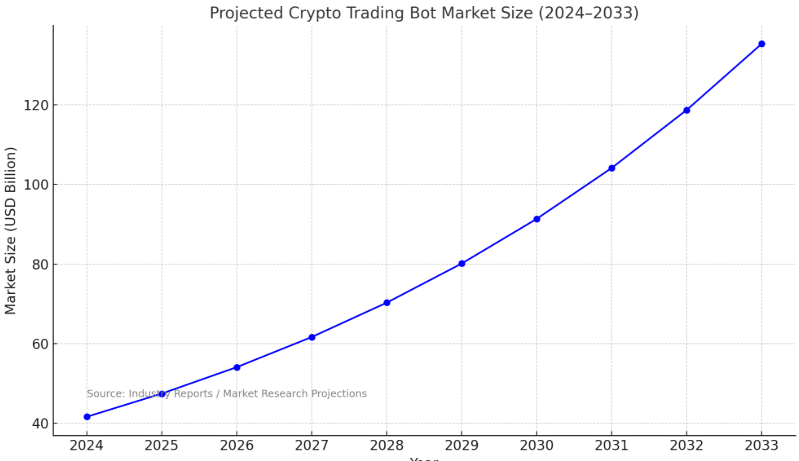With the increasing volatility in the cryptocurrency market, automated tools like trading bots are gaining massive popularity. If you’re planning to build, you’re on the right track toward gaining an edge in 24/7 markets.
Whether you’re an individual trader or a startup, crypto trading bot can significantly enhance your trading capabilities.
These bots execute trades faster, more accurately, and without emotional bias. As demand rises for intelligent automation, many businesses and traders are now exploring how to make a crypto trading bot that’s efficient and secure.
In this blog, we’ll guide you step-by-step on how to build a crypto trading bot, key features to include, costs, and use cases.
What is Crypto Trading Bot?
A crypto trading bot is a software program that automatically buys and sells cryptocurrencies based on predefined algorithms. These bots analyze market data, execute trades, and manage portfolios without human intervention.
When you use a crypto trading bot, it helps reduce emotional decision-making and enhances precision. Many bots are configured to perform actions like arbitrage, market making, or technical analysis-based trading.
Today, traders rely on automated systems to optimize performance, especially in high-frequency trading environments. By integrating APIs from exchanges like Binance or Coinbase, users are now investing trading bots that works in real-time.
Why use Automated Trading Bot?
Crypto trading bots offers traders the advantage of instant decision-making based on data-driven algorithms, eliminating emotional biases and delays.
These bots operate round-the-clock, allowing for uninterrupted trading and the ability to capitalize on opportunities even during off-hours. They can simultaneously manage multiple trading pairs, monitor markets, and execute complex strategies with precision.
Additionally, back testing capabilities enable users to test strategies on historical data, refining them before live deployment. Crypto trading bots, it brings consistency, scalability, and adaptability key benefits in the fast-paced and volatile world of cryptocurrency trading.
Crypto Trading Bot Global Market Size
The crypto trading bot market was estimated at around USD 41.61 billion in 2024 and is projected to reach USD 154 billion by 2033, with a CAGR of approximately 14% from 2025 to 2033.
This impressive growth is driven by the rising popularity of automated, self-service trading solutions among both retail and institutional investors, who are increasingly embracing technology to streamline and optimize their trading activities.
How to Build a Crypto Trading Bot From Scratch?
Crypto trading bot should be developed with a proper process to ensure the better functionality and to achieve expected outcomes. Here’s a step-by-step guide on how to make a crypto trading bot from scratch.
Step 1: Define Trading Strategy
Start by deciding your bot’s core strategy arbitrage, scalping, or swing trading. This ensures that your crypto bot works in alignment with your financial goals.
Step 2: Choose a Programming Language
Popular languages include Python and JavaScript for their flexibility and exchange API compatibility. They are beginner-friendly and ideal to building crypto trading bots scripts.
Step 3: Select Crypto Exchange and Integrate API
Pick reputable exchanges like Delta Exchange, Coinbase, or Kraken. Use their APIs to feed real-time data to the bot and allow it to execute trades securely.
Step 4: Develop Core Bot Architecture
Design modules for market analysis, trade execution, portfolio tracking, and risk management.
Step 5: Back testing and Optimization
Before going live, run simulations using historical market data. Backtesting ensures your strategy is viable and reduces the risk of loss in real-world conditions.
Step 6: Deployment and Monitoring
Deploy the bot on a secure cloud or server. Monitor its activity regularly to ensure it functions correctly and adapts to market changes effectively.
Features to Incorporate in Crypto Trading Bot
Incorporating essential features is key to maximizing performance, security, and user experience. These functionalities empower the bot to execute trades efficiently, manage risks smartly, and adapt to market trends with minimal human intervention.
1. Real-Time Market Data Analysis
The bot must continuously analyze real-time market data from multiple exchanges. This allows it to react instantly to price movements, volume changes, and trading signals resulting in smarter decisions, better timing, and optimized trade executions in highly volatile crypto markets.
2. Automated Trade Execution
Automatically executing buy/sell orders based on predefined rules reduces latency and removes emotional trading errors. This feature ensures timely responses to market events, allowing users to maintain consistent strategies and leverage quick shifts in the crypto market for optimal profitability.
3. Custom Strategy Builder
Allow users to design, test, and implement unique trading strategies without coding. This feature is ideal for both beginners and professionals learning how to make a crypto trading bot tailored to their risk tolerance, technical indicators, and financial objectives.
4. Backtesting Tools
Backtesting enables users to simulate their trading strategies on historical market data. It helps identify weaknesses, refine parameters, and verify profitability before deploying the bot live. This reduces risks and improves performance.
5. Risk Management Controls
Integrate advanced features like stop-loss, take-profit, and trailing stop orders. These automatically secure profits or limit losses, ensuring capital protection. Essential for crypto in unpredictable markets with rapid price fluctuations and high volatility.
6. Multi-Exchange Support
Enabling connections to multiple exchanges diversifies trading opportunities and reduces dependency on a single platform. It enhances liquidity access, allows arbitrage strategies, and gives traders broader reach when using or attempting to build for scaling.
7. User Dashboard and Analytics
An intuitive dashboard provides real-time insights into trades, performance, portfolio status, and bot activity. Advanced analytics help users identify profitable strategies and optimize performance, making it easier to monitor progress.
8. Security and Encryption
Implementing two-factor authentication, encrypted API keys, and secure login protocols is critical for protecting assets. These features are non-negotiable that handle sensitive data, private keys, and real-time transactions across various exchanges.
Cost to Build Crypto Trading Bot
The cost depends on various factors such as complexity, features, technology stack, and the development team’s expertise. On average, a basic trading bot with standard functionalities may cost between $10,000 to $19,000, while advanced bots with real-time analytics, AI integration, and multi-exchange support will cost more.
Choosing customized solutions over pre-built ones may involve higher costs but delivers better long-term performance and flexibility for traders with specific needs and strategies.
In the table below, we have listed different phases of a basic app along with its estimated cost.
| Component | Estimated Cost (USD) |
| Strategy Design & Research | $1,000 – $2,000 |
| Bot Architecture Development | $2,000 – $4,000 |
| Exchange API Integration | $1,000 – $2,000 |
| Backtesting Module | $1,500 – $3,000 |
| Dashboard UI/UX | $1,500 – $2,500 |
| Security & Compliance Features | $2,000 – $3,500 |
| QA, Testing & Deployment | $1,000 – $2,000 |
| Total Estimated Cost | $10,000 – $19,000 |
Use Cases of Crypto Trading Bot
Crypto trading bots are versatile tools that automate various trading activities. It can serve multiple use cases tailored to different trading goals and strategies.
1. Arbitrage Trading
Take advantage of price differences between exchanges. This strategy is ideal for focused on profit margins.
2. Portfolio Rebalancing
Maintain an ideal asset allocation automatically. The bot periodically adjusts holdings to match predefined investment ratios.
3. High-Frequency Trading
Execute thousands of trades per second to capitalize on minor price movements. Essential when you building with speed in mind.
4. Market Making
Place both buy and sell orders to earn spreads. A popular strategy among those learning for continuous activity.
5. Trend Following
Use technical indicators to identify market trends. Bots enter trades in the direction of the trend and exit during reversals.
6. Stop-Loss Management
Automatically exit losing positions at a predetermined price. Reduces emotional interference and protects capital.
Final Thoughts
Crypto trading automation is revolutionizing the way traders operate in the digital asset space. After Knowing all things allows for tailored, efficient, and secure trading operations.
By incorporating essential features and following the right development approach, you can make solutions that cater to both individual and enterprise needs. Businesses looking for automated trading bot for crypto should prioritize reliability, speed, and security.
Crypto Trading Bot Related FAQs
1. How long does it take to build a crypto trading bot?
It typically takes 4–8 weeks, depending on features, exchange integrations, and security layers. Fast delivery is possible with an experienced agency.
2. Can I make a crypto trading bot without coding?
Yes, using no-code platforms or hiring a firm, you can make with minimal technical knowledge.
3. Is it safe to use a crypto trading bot?
Yes, if developed with strong encryption and APIs. Make sure you are useing secure cloud hosting and API key management.
4. What strategies can be used in crypto trading bots?
Strategies include arbitrage, scalping, trend following, and market making. Choose one that suits your trading goals and risk tolerance.
 +91 7014607737
+91 7014607737
 info@technoloader.com
info@technoloader.com




